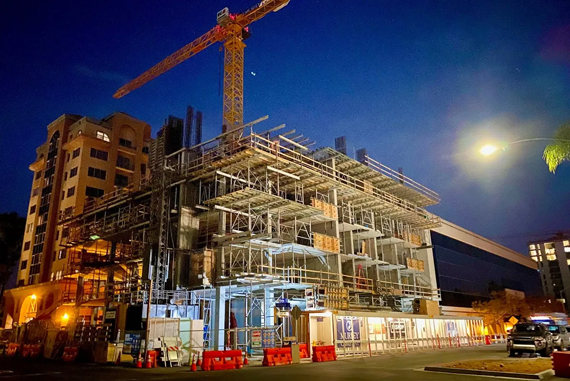|
Historic Preservation is Not the Cause of the Housing Crisis—Developers Are
By SOHO Staff
May/June 2025
 Housing construction in San Diego. Courtesy of the city of San Diego |
The development industry unfairly scapegoats historic preservation for the housing affordability crisis, but the facts tell a different story. In major U.S. cities, historic designations apply to only a tiny fraction of buildings; in San Diego, the total is far less than half of 1%. It is absurd to suggest that such a small percentage of protected structures is a significant barrier to new housing construction.
The real culprit behind high housing costs isn’t preservation; it’s the real estate market itself. Developers and investors drive up prices through speculation, luxury construction, and profit-driven policies that favor high-end development over truly affordable housing. Yet, instead of addressing these root causes, they blame preservationists, the ones who are actually fighting to protect the cultural fabric, existing naturally occurring affordable housing (NOAH), small businesses, and the historic character of our communities.
The claim that preservation worsens inequality is another misleading notion designed to distract people from the real issue: the development industry’s relentless pursuit of profit. In San Diego, it’s not historic districts or preservation ordinances that are making housing unaffordable. It’s unchecked market forces, waived fees, and developer-friendly policies.
SOHO maintains it is time to stop blaming preservationists and start holding developers accountable for the widespread crisis, distress, and displacement they helped create.
Recent news articles and analyses make it clear that developers in San Diego are not building affordable housing primarily because it is not profitable compared to market-rate or luxury homes. Here are several published accounts that support this finding:
According to an Axios report from 2024, the cost to build new low-income housing in San Diego is extremely high—as much as $900,000 per unit in some projects. City planners acknowledge that 2024's spike in affordable housing permits is unlikely to continue, in part because developers simply can't afford this.
An April 2024 commentary in Times of San Diego critiques the City of San Diego's "Complete Communities" program, showing how developers exploit loopholes to minimize their affordable housing obligations. Instead of incorporating required affordable units into their project, developers move them offsite—often to lower-income neighborhoods. Or, they pay fees, which are intended to be penalties, but cost a fraction of actually constructing affordable homes. The article bluntly states that these practices are driven by the industry's desire for higher profits and lower costs, and that the current system "creates more immediate jobs for the developers and contractors whose interests it represents," while failing to deliver meaningful affordable housing. The bottom line: developers avoid building affordable housing altogether, despite regulatory incentives and density bonuses that could make it feasible.
Housing justice advocates and some local reporting argue that YIMBYs promote a "neoliberal" approach, prioritizing overall housing supply (including market-rate and luxury units) and assuming that affordability will follow. Critics say this approach does little to guarantee affordable housing and may accelerate gentrification, displacement, and profit for developers.
Policy Outcomes and Developer Benefits
Recent San Diego reforms supported by YIMBYs, such as the elimination of single-family zoning and increased allowable ADUs (Accessory Dwelling Units), have indeed made it easier for developers to build more units, but most of these are market-rate or moderate-income homes, not affordable. Critics argue YIMBY claims about affordable housing are, at best, overstated.
The facts are clear: historic preservation is not to blame for the affordable housing crisis. It's time to hold developers and their policymaking allies accountable—and demand real, systemic change to ensure thousands more families can access stable, affordable homes.
BACK to table of contents
|
2025
2024
2023
2022
2021
2020
2019
2018
2017
2016
2015
|




